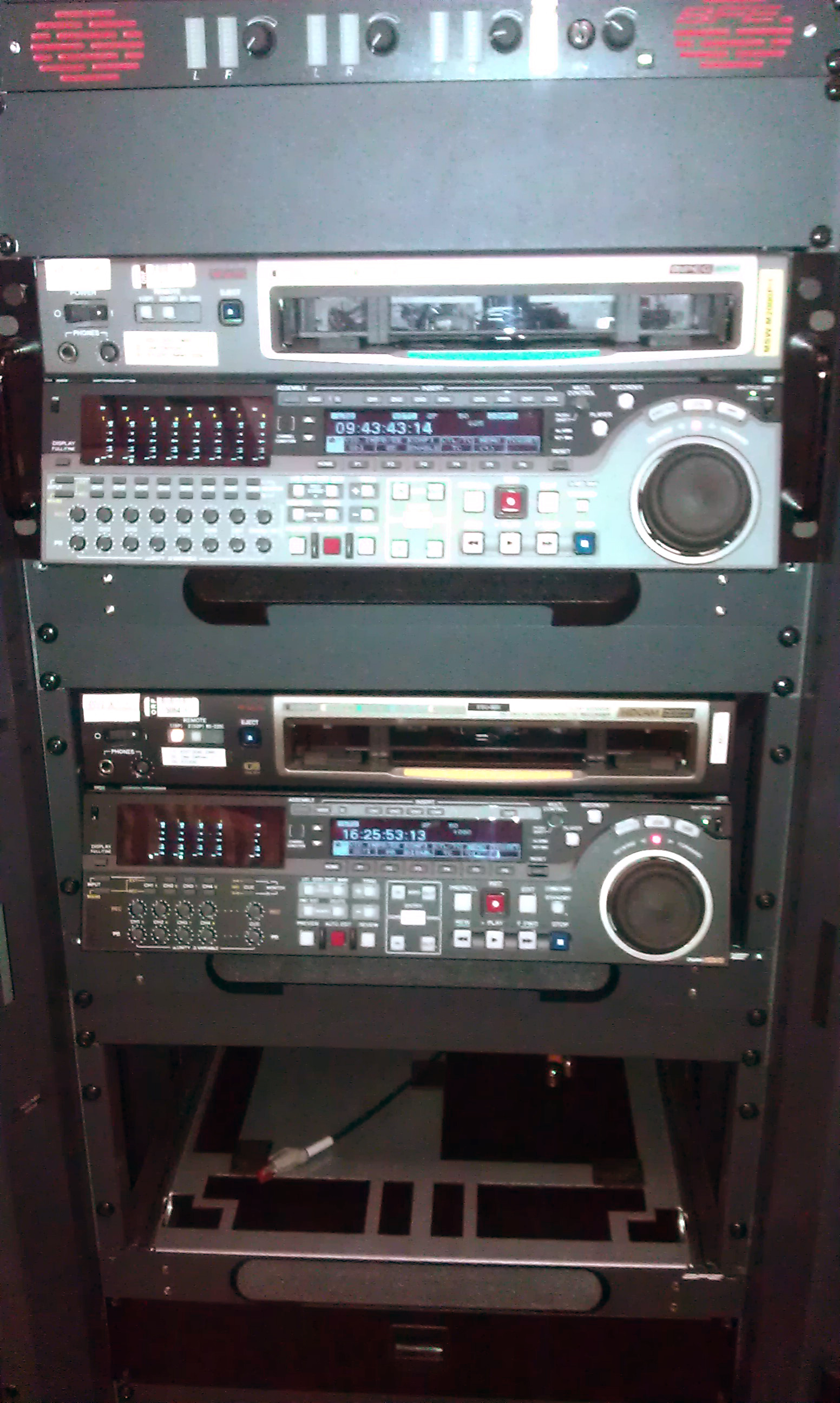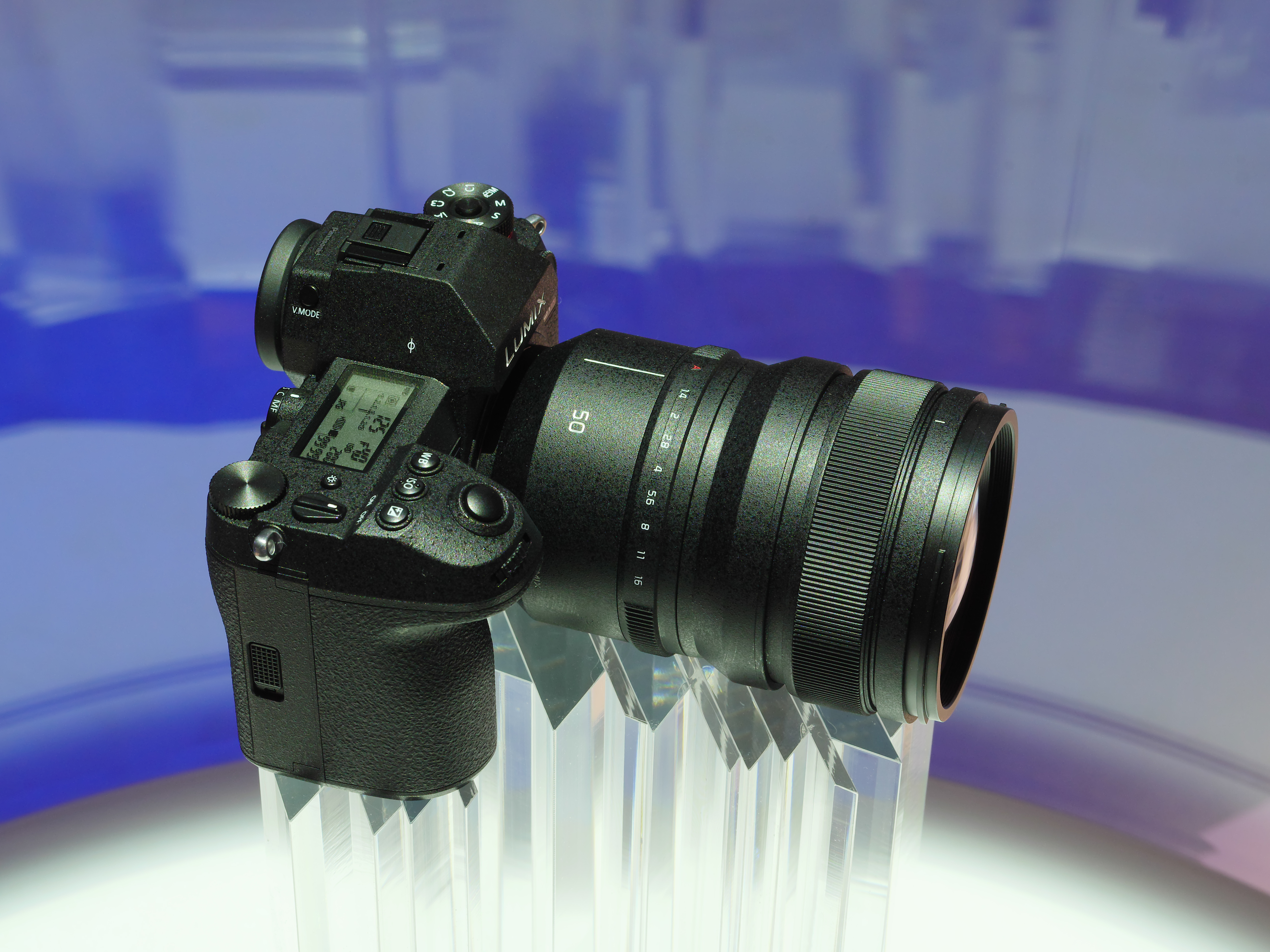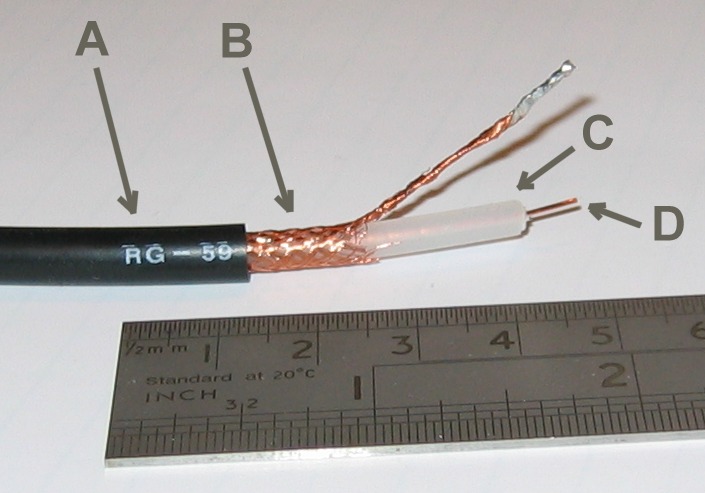|
D1 (Sony)
D-1 or 4:2:2 Component Digital is an SMPTE digital recording video standard, introduced in 1986 through efforts by SMPTE engineering committees. It started as a Sony and Bosch – BTS product and was the first major professional digital video format. SMPTE standardized the format within ITU-R 601 (orig. CCIR-601), also known as Rec. 601, which was derived from SMPTE 125M and EBU 3246-E standards. Format D-1 or 4:2:2 D-1 (1986) was a major feat in real time, broadcast quality digital video recording. It stores uncompressed digitized component video, encoded at Y'CbCr 4:2:2 using the CCIR 601 raster format with 8 bits, along with PCM audio tracks as well as timecode on a 3/4 inch (19 mm) videocassette tape (though not to be confused with the ubiquitous 3/4-inch U-Matic/U-Matic SP cassette). The uncompressed component video used enormous bandwidth for its time: 167 Mbit/sec (bit rate). One of the first D-1 VTRs, the Sony DVR-1000, required a separate ... [...More Info...] [...Related Items...] OR: [Wikipedia] [Google] [Baidu] |
Magnetic Tape
Magnetic tape is a medium for magnetic storage made of a thin, magnetizable coating on a long, narrow strip of plastic film. It was developed in Germany in 1928, based on the earlier magnetic wire recording from Denmark. Devices that use magnetic tape can with relative ease record and play back audio, visual, and binary computer data. Magnetic tape revolutionized sound recording and reproduction and broadcasting. It allowed radio, which had always been broadcast live, to be recorded for later or repeated airing. Since the early 1950s, magnetic tape has been used with computers to store large quantities of data and is still used for backup purposes. Magnetic tape begins to degrade after 10–20 years and therefore is not an ideal medium for long-term archival storage. The exception is data tape formats like Linear Tape-Open, LTO which are specifically designed for long-term archiving. Information in magnetic tapes is often recorded in tracks which are narrow and long areas of in ... [...More Info...] [...Related Items...] OR: [Wikipedia] [Google] [Baidu] |
Pulse-code Modulation
Pulse-code modulation (PCM) is a method used to digitally represent analog signals. It is the standard form of digital audio in computers, compact discs, digital telephony and other digital audio applications. In a PCM stream, the amplitude of the analog signal is sampled at uniform intervals, and each sample is quantized to the nearest value within a range of digital steps. Alec Reeves, Claude Shannon, Barney Oliver and John R. Pierce are credited with its invention. Linear pulse-code modulation (LPCM) is a specific type of PCM in which the quantization levels are linearly uniform. This is in contrast to PCM encodings in which quantization levels vary as a function of amplitude (as with the A-law algorithm or the μ-law algorithm). Though ''PCM'' is a more general term, it is often used to describe data encoded as LPCM. A PCM stream has two basic properties that determine the stream's fidelity to the original analog signal: the sampling rate, which is the number of ... [...More Info...] [...Related Items...] OR: [Wikipedia] [Google] [Baidu] |
D-2 (video)
D-2 is a professional digital videocassette format created by Ampex and introduced in 1988 at the NAB Show as a composite video alternative to the component video D-1 format. It garnered Ampex a technical Emmy in 1989. Like D-1, D-2 stores uncompressed digital video on a tape cassette; however, it stores a composite video signal, rather than component video as with D-1. While component video is superior for advanced editing, especially when chroma key effects are used, composite video was more compatible with most analog facilities existing at the time. History Ampex created the first D-2 video machine, the ACR-225 commercial spot player working with Sony, who had done some early research into composite digital video, as a cost-effective solution for TV broadcasters with large investments in composite analog infrastructure such as video routers and switchers, since it could be inserted into existing analog broadcast facilities without extensive redesign or modifications ... [...More Info...] [...Related Items...] OR: [Wikipedia] [Google] [Baidu] |
Betacam
Betacam is a family of half-inch professional videocassette products developed by Sony in 1982. In colloquial use, ''Betacam'' singly is often used to refer to a Betacam camcorder, a Betacam tape, a Betacam video recorder or the format itself. All Betacam variants from analog Betacam, Betacam SP and Digital Betacam, HDCAM and HDCAM SR use the same shape videocassettes, meaning vaults and other storage facilities do not have to be changed when upgrading to a new format. The cassette shell and case for each Betacam cassette is colored differently depending on the format, allowing for easy visual identification. There is also a mechanical key that allows a video tape recorder to identify which format has been inserted. The cassettes are available in two sizes: S (short or small) and L (long or large). The Betacam camcorder can only load S magnetic tapes, while television studio sized video tape recorders (VTR) designed for video editing can play both S and L tapes. The format s ... [...More Info...] [...Related Items...] OR: [Wikipedia] [Google] [Baidu] |
D5 HD
D-5 is a professional digital video format introduced by Panasonic at 18th International Television Symposium in Montreux in 1993 and released a year later in 1994. Overview Like Sony's D-1 (8-bit), it is an uncompressed digital component system (10-bit), but uses the same half-inch tapes as Panasonic's digital composite D-3 format. A 120 min. D-3 tape will record 60 min. in D-5/D-5 HD mode. D-5 standard definition (SD) decks can be retrofitted to record high definition with the use of an external HD input/output box/decoder. There were native D5 HD decks as well that didn't need an external processor and could record in both SD and HD. High definition conversion on D5 HD decks does not allow for any error correction that exists on standard definition recordings, as the full bandwidth of the tape is required for high definition recording. D-5 HD D-5 HD uses standard D-3/D-5 videocassettes to record HD material, using an intra-frame compression with a 4:1 ratio. It was introdu ... [...More Info...] [...Related Items...] OR: [Wikipedia] [Google] [Baidu] |
Panasonic
is a Japanese multinational electronics manufacturer, headquartered in Kadoma, Osaka, Kadoma, Japan. It was founded in 1918 as in Fukushima-ku, Osaka, Fukushima by Kōnosuke Matsushita. The company was incorporated in 1935 and renamed and changed its name to in 2008. In 2022, it reorganized as a holding company and adopted its current name. In addition to consumer electronics, for which it was the world’s largest manufacturer in the late 20th century, Panasonic produces a wide range of products and services, including Rechargeable battery, rechargeable batteries, automotive and avionic systems, industrial equipment, as well as home renovation and construction. The company is listed on the Tokyo Stock Exchange and is a constituent of the Nikkei 225 and TOPIX, TOPIX 100 indices, with a secondary listing on the Nagoya Stock Exchange. Corporate name From 1925 to October 1, 2008, the company's corporate name was "Matsushita Electric Industrial Co." (MEI). On January 10, 2008, ... [...More Info...] [...Related Items...] OR: [Wikipedia] [Google] [Baidu] |
Color Space
A color space is a specific organization of colors. In combination with color profiling supported by various physical devices, it supports reproducible representations of colorwhether such representation entails an analog or a digital representation. A color space may be arbitrary, i.e. with physically realized colors assigned to a set of physical color swatches with corresponding assigned color names (including discrete numbers infor examplethe Pantone collection), or structured with mathematical rigor (as with the NCS System, Adobe RGB and sRGB). A "color space" is a useful conceptual tool for understanding the color capabilities of a particular device or digital file. When trying to reproduce color on another device, color spaces can show whether shadow/highlight detail and color saturation can be retained, and by how much either will be compromised. A "color model" is an abstract mathematical model describing the way colors can be represented as tuples of numbers (e. ... [...More Info...] [...Related Items...] OR: [Wikipedia] [Google] [Baidu] |
Coaxial Cable
Coaxial cable, or coax (pronounced ), is a type of electrical cable consisting of an inner Electrical conductor, conductor surrounded by a concentric conducting Electromagnetic shielding, shield, with the two separated by a dielectric (Insulator (electricity), insulating material); many coaxial cables also have a protective outer sheath or jacket. The term ''coaxial'' refers to the inner conductor and the outer shield sharing a geometric axis. Coaxial cable is a type of transmission line, used to carry high-frequency Signal, electrical signals with low losses. It is used in such applications as telephone trunk lines, Internet access, broadband internet networking cables, high-speed computer bus (computing), data buses, cable television signals, and connecting Transmitter, radio transmitters and Radio receiver, receivers to their Antenna (radio), antennas. It differs from other shielded cables because the dimensions of the cable and connectors are controlled to give a precise, ... [...More Info...] [...Related Items...] OR: [Wikipedia] [Google] [Baidu] |
Serial Digital Interface
Serial digital interface (SDI) is a family of digital video Interface (computing), interfaces first standardized by SMPTE (The Society of Motion Picture and Television Engineers) in 1989. For example, ITU-R BT.656 and SMPTE 259M define digital video interfaces used for Broadcasting, broadcast-grade video. A related standard, known as high-definition serial digital interface (HD-SDI), is standardized in SMPTE 292M; this provides a nominal data rate of 1.485 Gbit/s. Additional SDI standards have been introduced to support increasing video resolutions (High definition video, HD, Ultra high definition, UHD and beyond), High frame rate, frame rates, 3D video, stereoscopic (3D) video, and color depth. Dual link HD-SDI consists of a pair of SMPTE 292M links, standardized by SMPTE 372M in 1998; this provides a nominal 2.970 Gbit/s interface used in applications (such as digital cinema or HDTV 1080P) that require greater fidelity and resolution than standard HDTV can provide. 3 ... [...More Info...] [...Related Items...] OR: [Wikipedia] [Google] [Baidu] |
DB-25
The D-subminiature or D-sub is a common type of electrical connector. They are named for their characteristic D-shaped metal shield. When they were introduced, D-subs were among the smallest connectors used on computer systems. Description, nomenclature, and variants A D-sub contains two or more parallel rows of pins or sockets usually surrounded by a D-shaped metal shield, or shell, that provides mechanical support, ensures correct orientation, and may screen against electromagnetic interference. Calling that shield a shell (or D-shell) can be ambiguous, as the term shell is also short for the cable shell, or backshell. D-sub connectors have gender: parts with pin contacts are called ''male connectors'' or ''plugs'', while those with socket contacts are called ''female connectors'' or ''sockets''. The socket's shield fits tightly inside the plug's shield. Panel-mounted connectors usually have #4-40 UNC (as designated with the Unified Thread Standard) jackscrews that ac ... [...More Info...] [...Related Items...] OR: [Wikipedia] [Google] [Baidu] |
Standard-definition Television
Standard-definition television (SDTV; also standard definition or SD) is a television system that uses a resolution that is not considered to be either high or enhanced definition. ''Standard'' refers to offering a similar resolution to the analog broadcast systems used when it was introduced. History and characteristics SDTV originated from the need for a standard to digitize analog TV (defined in BT.601) and is now used for digital TV broadcasts and home appliances such as game consoles and DVD disc players. Digital SDTV broadcast eliminates the ghosting and noisy images associated with analog systems. However, if the reception has interference or is poor, where the error correction cannot compensate one will encounter various other artifacts such as image freezing, stuttering, or dropouts from missing intra-frames or blockiness from missing macroblocks. The audio encoding is the last to suffer a loss due to the lower bandwidth requirements. Standards that suppor ... [...More Info...] [...Related Items...] OR: [Wikipedia] [Google] [Baidu] |
DVD-Video
DVD-Video is a consumer video format used to store digital video on DVDs. DVD-Video was the dominant consumer home video format in most of the world in the 2000s. As of 2024, it competes with the high-definition Blu-ray Disc, while both receive competition as delivery methods by streaming services such as Netflix and Disney+. Discs using the DVD-Video specification require a DVD drive and an MPEG-2 decoder (e.g., a DVD player, or a computer DVD drive with a software DVD player). Commercial DVD movies are encoded using a combination of MPEG-2 compressed video and audio of varying formats (often multi-channel formats as described below). Typically, the data rate for DVD movies ranges from 3 to 9.5 Mbit/s, and the bit rate is usually adaptive. DVD-Video was first available in Japan on October 19, 1996 (with major releases beginning December 20, 1996), followed by a release on March 24, 1997, in the United States. The DVD-Video specification was created by the DVD Forum a ... [...More Info...] [...Related Items...] OR: [Wikipedia] [Google] [Baidu] |








